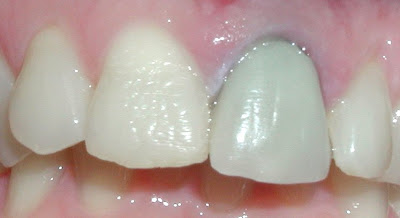This blog post is really a pictorial case study of a metal free crown and shows the importance of communicating the underlying shade to the laboratory.
The patient came to see us like this with an old PFM crown on the UL1 which needed replacing - a metal free crowns was requested by the dentists... but was this indicated cosmetically?
The simplest answer is, we don't know unless we can see what's underneath. So we asked the dentist to take a photo of the preparation and hold a shade guide to it so we could gauge the darkness of the tooth.
Once we knew the underlying tooth shade it is then possible to take a shade match, making an informed decision about the ceramic. For example, if we take a shade for a crown that is going to be really thin, then it may be that there is not enough ceramic material thickness to achieve that shade - so we may decide to make an A2 crown in A3 ceramic if that ceramic is going to be thin.
Also, if the underlying tooth is very dark, then we may decide to mix in a little A1 to the A2 ceramic to lighten it slightly to compensate.
So, we took the shade of the patient's tooth, and drew a detailed plan of the colours. Notice 2 things:
- We've taken a shade of the lingual as this will inevitably shine through and affect the colour of the labial
- We have taken a 3D shade, in other words we could see that the shade needed an overlay of enamel (EN2) and ultra clear (WIN)
We then went ahead and finished the crown - this is it in situ.
Overall the result was excellent for the patient, and having the underlying tooth shade helped us work with this in order to choose the correct ceramic to make the crown with.
















